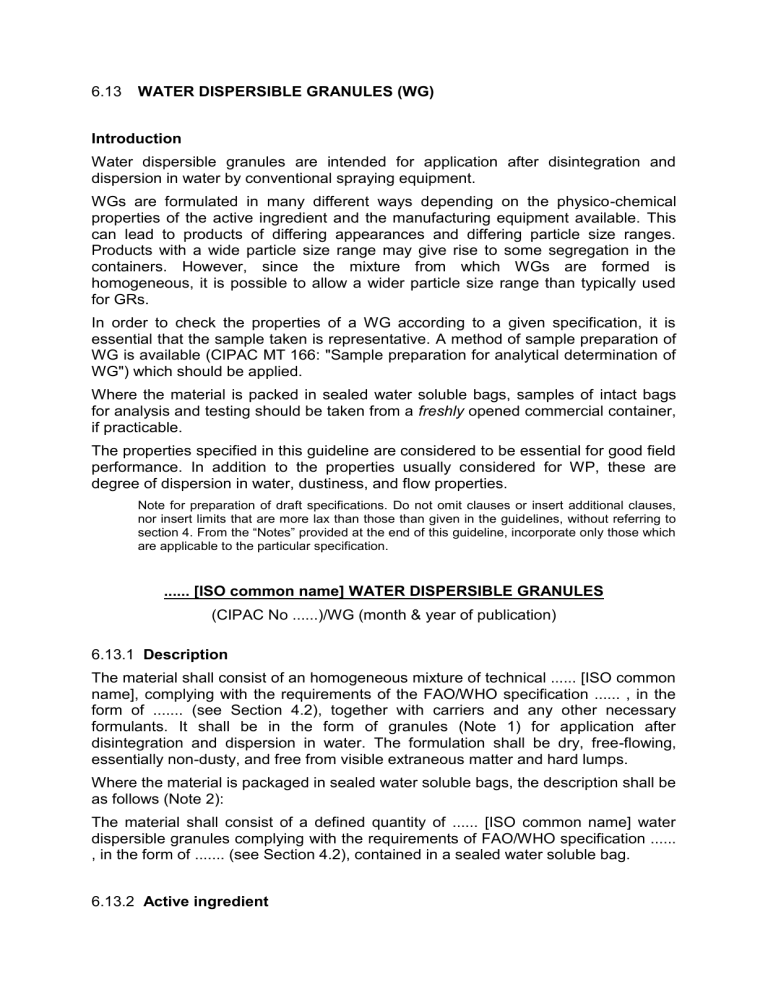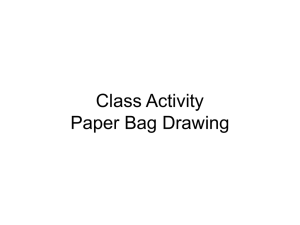6.13 WATER DISPERSIBLE GRANULES (WG) Introduction Water

6.13 WATER DISPERSIBLE GRANULES (WG)
Introduction
Water dispersible granules are intended for application after disintegration and dispersion in water by conventional spraying equipment.
WGs are formulated in many different ways depending on the physico-chemical properties of the active ingredient and the manufacturing equipment available. This can lead to products of differing appearances and differing particle size ranges.
Products with a wide particle size range may give rise to some segregation in the containers. However, since the mixture from which WGs are formed is homogeneous, it is possible to allow a wider particle size range than typically used for GRs.
In order to check the properties of a WG according to a given specification, it is essential that the sample taken is representative. A method of sample preparation of
WG is available (CIPAC MT 166: "Sample preparation for analytical determination of
WG") which should be applied.
Where the material is packed in sealed water soluble bags, samples of intact bags for analysis and testing should be taken from a freshly opened commercial container, if practicable.
The properties specified in this guideline are considered to be essential for good field performance. In addition to the properties usually considered for WP, these are degree of dispersion in water, dustiness, and flow properties.
Note for preparation of draft specifications. Do not omit clauses or insert additional clauses, nor insert limits that are more lax than those than given in the guidelines, without referring to section 4. From the “Notes” provided at the end of this guideline, incorporate only those which are applicable to the particular specification.
...... [ISO common name] WATER DISPERSIBLE GRANULES
(CIPAC No ......)/WG (month & year of publication)
6.13.1 Description
The material shall consist of an homogeneous mixture of technical ...... [ISO common name], complying with the requirements of the FAO/WHO specification ...... , in the form of ....... (see Section 4.2), together with carriers and any other necessary formulants. It shall be in the form of granules (Note 1) for application after disintegration and dispersion in water. The formulation shall be dry, free-flowing, essentially non-dusty, and free from visible extraneous matter and hard lumps.
Where the material is packaged in sealed water soluble bags, the description shall be as follows (Note 2):
The material shall consist of a defined quantity of ...... [ISO common name] water dispersible granules complying with the requirements of FAO/WHO specification ......
, in the form of ....... (see Section 4.2), contained in a sealed water soluble bag.
6.13.2 Active ingredient
6.13.2.1 Identity tests (Note 3)
The active ingredient shall comply with an identity test and, where the identity remains in doubt, shall comply with at least one additional test.
6.13.2.2 ...... [ISO common name] content (Note 3)
The ...... [ISO common name] content shall be declared (g/kg) and, when determined, the average content measured shall not differ from that declared by more than the appropriate tolerance, given in the table of tolerances, Section 4.3.2.
6.13.3 Relevant impurities
6.13.3.1 By-products of manufacture or storage (Note 4), if required
Maximum: ......% of the …… [ISO common name] content found under
6.13.2.2.
6.13.3.2 Water (MT 30.5) (Notes 5 & 6)
Maximum: ...... g/kg.
6.13.4 Physical properties
6.13.4.1 Acidity and/or Alkalinity (MT 191) or pH range (MT 75.3) (Note 6), if required
Maximum acidity: ...... g/kg calculated as H
2
SO
4
.
Maximum alkalinity: ...... g/kg calculated as NaOH. pH range: ...... to ......
6.13.4.2 Wettability (MT 53.3) (Note 7)
The formulation shall be completely wetted in ...... min.
6.13.4.3 Wet sieve test (MT 185)
Maximum: ......% retained on a
75 µm test sieve.
6.13.4.4 Degree of dispersion (MT 174)
Dispersibility: minimum ......% after 1 minute of stirring.
6.13.4.5 Suspensibility (
‡ MT 184) (Notes 8 & 9)
A minimum of ......% shall be in suspension after 30 min in CIPAC
Standard Water D at 30 ± 2°C (Note 10).
In the case of water soluble bag packaging, the requirements of clause
6.13.6.3 should be applied.
6.13.4.6 Persistent foam (MT 47.2) (Note 11)
Maximum: ...... ml after 1 minute.
6.13.4.7 Dustiness (MT 171) (Note 12)
Essentially non-dusty.
6.13.4.8 Flowability (MT172)
At least ......% of the formulation shall pass through a 5 mm test sieve after 20 drops of the sieve (Note 13).
6.13.4.9 Attrition resistance (MT 178.2)
Minimum: ......% attrition resistance.
6.13.5 Storage stability
6.13.5.1 Stability at elevated temperature (MT 46.3)
After storage at 54
2
C for 14 days (Note 14), the determined average active ingredient content must not be lower that ......% relative to the determined average content found before storage (Note 15) and the formulation shall continue to comply with the clauses for:
- by-products of manufacture or storage (6.13.3.1),
- acidity/alkalinity/pH range (6.13.4.1),
- wet sieve test (6.13.4.3),
- degree of dispersion (6.13.4.4),
- suspensibility (6.13.4.5),
- dustiness (6.13.4.7),
- attrition resistance (6.13.4.8), as required.
In the case of water soluble bag packaging, the package should be enclosed in a watertight sachet, box or any other container at ......
C
(Note 16) for ...... days. The determined average active ingredient content must not be lower than ......% relative to the determined average content found before storage, and the formulation shall continue to comply with the clauses for:
- by-products of manufacture or storage (6.13.3.1),
- acidity/alkalinity/pH range (6.13.4.1),
- degree of dispersion (6.13.4.4),
- dissolution of the bag (6.13.6.1),
- suspensibility (6.13.6.2), as required. None of the bags tested should show signs of leakage or rupture during normal handling, before and after storage.
6.13.6 Material packaged in a sealed water soluble bag (Notes 17, 18 & 19)
6.13.6.1 Dissolution of the bag (MT 176)
The dissolution of the bag shall be tested on a sample of the emptied and cleaned bag taken according to the procedure described in Note 18, together with an appropriate proportion of the WG.
Flow time of the suspension: maximum ...... sec.
6.13.6.2 Suspensibility (
‡ MT 184) (Notes 8, 9 & 19)
The suspensibility shall be tested on a suspension containing the WG and the bag material in the actual ratio of application, prepared according to the procedure described in Note 18.
A minimum of ......% shall be in suspension after 30 min in CIPAC
Standard Water D at 30
± 2°C (Notes 9 & 10).
6.13.6.3 Persistent foam (MT 47.2) (Note 11)
The persistent foam shall be tested on a suspension containing the WG and the bag in the actual ratio of application, prepared according to the procedure described in note 19.
________________________
Note 1 Depending on the manufacturing conditions, WGs may have different forms and particle size ranges. To describe specific formulations, it is recommended that information about the form
(e.g. irregular shape, nearly spherical, cylindrical...) is added and the nominal size range stated.
Note 2 For record keeping purposes, the suffix "SB" should be added to the formulation code (WG-
SB).
Note 3 Method(s) of analysis must be CIPAC, AOAC or equivalent. If the methods have not yet been published then full details, with appropriate method validation data, must be submitted to FAO/WHO by the proposer.
Note 4 This clause should include only relevant impurities and the title should be changed to reflect the name of the relevant impurity. Method(s) of analysis must be peer validated.
Note 5 There may be cases where a minimum water content has to be specified.
Note 6 The method to be used shall be stated. If several methods are available, a referee method shall be selected.
Note 7 The method to be used shall be stated, either with or without swirling.
Note 8 The formulation should be tested at the highest and lowest rates of use recommended by the supplier, provided this does not exceed the conditions given in method ‡ MT 184.
Note 9 Chemical assay is the only fully reliable method to measure the mass of active ingredient still in suspension. ‡ In case of dispute, chemical assay shall be the "referee method".
Note 10 Unless another temperature is specified.
Note 11 The mass of sample to be used in the test should be specified at the highest rate recommended by the supplier. The test is to be conducted in CIPAC standard water D.
Note 12 Measurement of dustiness must be carried out on the sample "as received" and, where practicable, the sample should be taken from a newly opened container, because changes in the water content of samples may influence dustiness significantly. The optical method,
MT 171.2, usually shows good correlation with the gravimetric method, MT 171.1, and can, therefore, be used as an alternative where the equipment is available. Where the correlation is in doubt, it must be checked with the formulation to be tested. In case of dispute the gravimetric method shall be used.
Note 13 Flowability (MT 172). MT 46.3 (solid formulations stored under pressure) should be substituted for MT 46.1, which is specified for use in MT 172.
Note 14 Unless other temperatures and/or times are specified. Refer to Section 4.6.2 of this Manual for alternative storage conditions.
Note 15 Analysis of the formulation, before and after the storage stability test, should be carried out concurrently (i.e. after storage) to reduce analytical error.
Note 16 If irreversible changes in the characteristics of the bag material are known to occur when stored at elevated temperatures, refer to Section 4.6.2 of this Manual for alternative storage conditions.
Note 17 Sub-sampling.
Lay the bag on a bench and carefully open one side of the bag with a cutter, taking care not to damage the seals. Transfer the contents of the bag into a suitable flask. This material shall be used to carry out the tests for:
- active ingredient identity (6.13.2.1),
- active ingredient content (6.13.2.2),
- by-products of manufacture or storage (6.13.3.1),
- water content (6.13.3.2),
- acidity/alkalinity/pH range (6.13.4.1),
- wettability (6.13.4.2),
- wet sieve test (6.13.4.3),
- degree of dispersion (6.13.4.4),
- dissolution of the bag (6.13.6.1),
- suspensibility (6.13.6.2),
- persistent foam (6.13.6.3), as required.
The bag is then opened on three sides, completely cleaned from adhering powder by brushing or suction and weighed to the nearest 0.01 g. It shall be used to carry out the dissolution test (6.13.6.1). Aliquots of an aqueous solution of the bag material shall be used in the suspensibility (6.13.6.2) and persistent foam (6.13.6.3) tests.
In the case of delay of the above tests, the bag shall be stored in a watertight container
(glass bottle or equivalent) to avoid any change in its properties.
Note 18 The sampling of the bag for the dissolution test should be as follows:
Lay the empty cleaned bag in its original configuration (double layer). Delineate and then cut up a test sample including part of the upper seal (5 cm) and symmetrically including the vertical seal (10 cm). If the size of the bag is less than this dimension, use the whole bag.
Carry out the dissolution test immediately to avoid any modification of the sample.
Note 19 The procedure for adding the bag material to the solution for the tests for dissolution of the bag, suspensibility and persistent foam should be as follows:
"Prepare a stock solution of the bag material (1 mg/ml) by weighing approximately a 100 mg sample (n mg) of the bag (excluding sealed parts) to the nearest mg. Dissolve this sample by stirring in the standard water used for the tests to give a final volume of n ml. Store the stock solution in a stoppered bottle before use.
Calculate the volume (V ml) of the stock solution of the bag to be added to the test suspension of the water dispersible granule according to the following equation:
V(ml) = X x 1000B
W where: B (g) = weight of the emptied and cleaned bag
W (g) = nominal weight of the WG contained in the bag
X (g) = weight of the WG sample used in the test.





